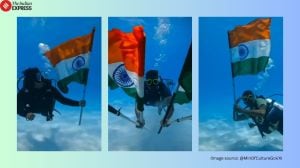Mumbai ferry accident: Boat operators question lack of oversight, regulations on busy passenger route
Experts said after the Mumbai ferry accident, the onus now lies on authorities to ensure the seas are navigated with care and accountability.
 The absence of a monitoring mechanism, such as GPS systems on smaller boats, has turned the sea into a risky zone for both operators and passengers.
The absence of a monitoring mechanism, such as GPS systems on smaller boats, has turned the sea into a risky zone for both operators and passengers. Gateway of India, a bustling maritime hub in Mumbai, sees hundreds of boats navigating its waters daily. Yet, alarm bells have been rung regarding safety, after the collision between an Indian Navy speedboat and a wooden passenger ferry, claiming 13 lives, including Navy personnel and civilians.
After the Mumbai ferry accident, boat operators are pointing to the lack of regulation and monitoring in one of India’s busiest harbours. They said that the Navy generally conducts its boat testing during non-peak hours, primarily in the mornings.
Congested waters of Gateway Harbour
Sohel Kazani, Managing Partner, Infinity Harbour Services, a water taxi service provider, described Gateway of India Harbour as “the most congested” maritime stretch in the region. “At least 250 boats, including yachts, wooden ferries, and speedboats, operate simultaneously, but there’s no traffic control system in place,” Kazani says.
The absence of a monitoring mechanism, such as GPS systems on smaller boats, has turned the sea into a risky zone for both operators and passengers.
Kazani’s concerns stem from the December 18 collision near the Arabian Sea. The Navy speedboat, reportedly travelling at 25-30 nautical miles per hour, struck the passenger ferry operated by Neelkamal Company, carrying over 100 passengers. Rescue efforts saved 101 people, but 13 lives were lost — a sobering reminder of the need for robust safety measures.
Manik Gursal, CEO, Maharashtra Maritime Board (MMB), refused to comment and said that the area where the Mumbai boat accident happened falls within the jurisdiction of the Mumbai Port Trust Authority (MBPA).
Testing in non-peak hours
Boat operators said while the Navy generally conducts its boat testing exercises primarily in the mornings, they questioned Wednesday’s exercise which was carried out during a peak traffic period on a passenger route.
A retired Coast Guard official noted that the Navy follows standard operating procedures during such tests, but he too expressed surprise at the timing and location of this particular trial. “Testing in a high-traffic area that too during peak hours… Why was it done? Even I wonder,” he said.
When contacted, a Navy official said, “There is no fixed place to conduct testing and the collision of the boat to the passenger ferry boat was a mere accident. The Navy Personnel on the speedboat lost control and hit the passenger ferry. All necessary clearance was in place at time of testing and Navy Personnel are trained individuals and therefore it is a case of an accident happening due to losing control of the boat. Why it happened is part of the investigation which is underway.”
Kazani concurred, noting that Navy boats are typically seen patrolling the harbour, especially when chasing suspicious vessels. Yet, this incident underscores the dangers of testing on busy routes. “The mishap highlights the urgent need for traffic control measures,” he emphasised.
Another service provider echoed Kazani’s concerns, pointing out that while boat licenses are regularly renewed by MMB, monitoring of boat movements remains nonexistent. “There’s no system to regulate the movement of these boats, leaving safety to chance,” he said.
Kazani also highlighted the scale of operations at Gateway Harbour, where over 500 boats are registered with MMB. “A traffic control system is not just necessary; it’s overdue,” he asserted.
Aftermath of the accident
The accident has sparked a broader conversation about maritime safety at Gateway Harbour. Calls for stricter monitoring, mandatory GPS systems, and a dedicated traffic control system are growing louder. As Mumbai’s iconic waterfront struggles to balance bustling activity with safety, the tragedy serves as a grim reminder of the cost of inaction, experts pointed out.
They said with lives lost and questions unanswered, the onus now lies on authorities to ensure the seas are navigated with care and accountability. Only then can the Gateway of India truly serve as a safe passage for all who traverse its waters, expressed experts.
After the Mumbai ferry accident, which occurred at 4 pm, a massive rescue operation was launched. The Navy deployed 11 crafts and four helicopters to rescue the ferry passengers. While survivors are recovering, the families of the deceased grapple with their loss. Chief Minister Devendra Fadnavis has announced financial assistance of Rs 5 lakh from the Chief Minister’s Relief Fund for the next of kin of those who were killed in the accident.







